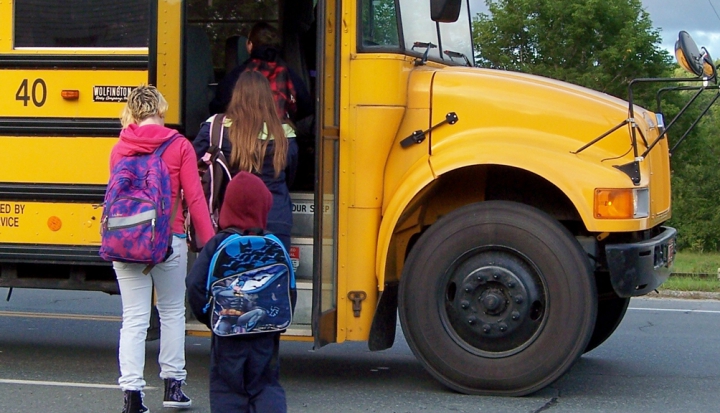Your child is approaching school age and you and your spouse want to give him or her the gift of a Catholic elementary education. Then you look at the tuition rates and realize it will cost more to send one of your children to school for one year than it cost your parents to send you and your siblings for eight years. As a couple, you look at your budget and you pray. You look at the budget again and pray harder, but the answer’s the same. You cannot possibly afford a Catholic education.
According to the U.S. Conference of Catholic Bishops, the current average cost of Catholic elementary school tuition per pupil is $3,673. In 1970, by contrast, a Catholic elementary education cost just $100. This 3,573 percent increase can largely be attributed to a dramatic decrease in nuns who once staffed Catholic schools. The vicious cycle is such that if we can’t afford Catholic schools, we are less likely to put young people in a position to recognize a religious calling that might in turn fill the religious orders and bring down the cost.
This brings us to the real problem: It isn’t just about the nuns or the cost; it’s about how to give our children the gift of faith. With so much on the line, how can we not afford a Catholic education?
Here are four questions to ask as you and your spouse decide on how to pursue a Catholic education for your child:
1. How can we make a Catholic school education affordable?
Several options exist to help with this dilemma:
Active Parishioner Scholarships: The first step is to look into Active Parishioner Scholarships. Most Catholic schools have two levels of tuition, one for parishioners and one for non-parishioners. Of course, this is only applicable for schools attached to a parish, an option not everyone may have. But in those schools that are parish-based, scholarships available for active parishioners can reduce tuition costs by as much as $1,000.
Family Volume Discount: The second discount comes in the form of volume discounts, a useful assistance for a community that is encouraged to raise large families. The volume discount for each additional child is around $1,400, making tuition for two students around $5,800, with additional discounts for each subsequent child. A family of four can expect to pay around $8,600 for all of their children, which might put them in the running for another associated discounted option known as the Large Family Fund.
Shop With Scrip: Another way to take the bite out of tuition is through the fundraising program known as Scrip. Participating retailers like Meijer, Kroger, Target, Wendy’s, and Kohl’s sell gift certificates to the school at a discounted price. The profit from the rebate is split 50/50, with one half going to the school and the other half to the student’s tuition. For example, a $100 gift certificate for the Gap has a 14 percent rebate, which puts $7 into the school and $7 into your children’s Scrip fund for the following school year. The average Scrip tuition rebate is around $400. The more actively you participate, the greater the discount.
Public Voucher Systems: Some dioceses have an agreement with the state that allows for a public voucher to be used toward a Catholic education. While controversial in some circles, it is not difficult to argue the public voucher’s merit. Catholic families still pay taxes that support public education. Our choice to not use the public school system we pay into saves the U.S. taxpayer $23 billion a year. Check with your diocese to see if public vouchers are an option in your state.
Prayer and Grace: Even with the above options, many still find Catholic education unaffordable. Prayer and grace may not seem like real-world solutions, but Catholic families have been getting by on them for years. Ask financially-strapped parents how they afforded a Catholic education and you’ll often hear variations on the same answer: “I don’t know how we did it. We didn’t have the money, but somehow it all worked out.” Prayer and grace are real. They work. If God wants it to happen, he’ll give us a way.
2. Do the Catholic schools in my area share my family’s values?
If a family is making the financial sacrifice to send their children to a Catholic school, the least they should expect is that the school is working as an extension of their family’s faith values. But what does this mean, and how can you be sure a school is providing the right faith-filled lessons?
Archbishop J. Michael Miller discusses the following characteristics set out by Pope John Paul II for what a Catholic school should have. It should be:
- Inspired by a supernatural vision, meaning the school should teach students they are meant for heaven;
- Founded on Christian anthropology, meaning Catholic schools must teach students to love one another as humans first and foremost instead of prioritizing a “success culture”;
- Animated by communion and community, meaning the school must emphasize their identity as a Catholic community;
- Imbued with a Catholic worldview throughout its curriculum, which means a Catholic catechism and the Gospel should imbue the entire curriculum; and lastly,
- Sustained by gospel witnesses, meaning teachers, administrators, and support staff at Catholic schools should themselves be practicing Catholics.
These may seem like high concepts, but they are not difficult to apply. Sit in on a class, take a tour, talk to parents with children attending the school. Ask how religion is incorporated into the daily lives of the students. Ask about the presence of priests in the classroom. Attend an all-school Mass and take note of how students are participating. Catholic values are a practice. Are they outwardly visible?
3. Should we explore the home schooling alternative?
Unfortunately, many families are in the position of living in an area where a Catholic education is not available or the cost is still prohibitive. Because of this, many families are pursuing the increasingly popular choice of home schooling. In fact, in North Carolina, the number of home-schooled children has now surpassed those attending private schools. Affordable Catholic curriculum such as Mother of Divine Grace, Kolbe Academy, Catholic Heritage Curricula, and Memoria Press are some of the favorites used by many home-schoolers.
The major advantages of home schooling are that it is cooperative with a family’s schedule and requires little time investment during the day (for example, a home school kindergarten curriculum amounts to one hour of study a day); it allows for a flexible study best suited to a child’s needs and skills; it is affordable; it gives parents control over the material; and despite criticism from the National Education Association, home schoolers show a higher rate of academic success in both their ACT scores and collegiate GPAs.
While parents may feel they are not “cut out” for home schooling, a home-schooling mother on a Catholic mommas website would argue that “God does not call the equipped; he equips the called one year at a time.”
4. Are public school plus a variety of youth-oriented faith formation classes a viable option?
Those who feel neither called nor equipped might have the good fortune of living in an area with an excellent public education system. This solves one dilemma for parents who are trying to give their children every possible advantage, but it doesn’t serve the pursuit of giving our children the gift of a Catholic faith. Fortunately, many parishes offer a variety of youth-oriented faith formation opportunities that can be incredibly effective in giving kids a real catechetical experience.
Children’s liturgy of the word, a program for pre-K students and kindergarteners, is the earliest of these opportunities. In parishes that offer this, children ages four to six are allowed to leave Mass and join their peers during the liturgy of the word. In a separate setting, the children participate in an age-appropriate teaching of the weekly readings that usually involves a coloring activity, a dramatic re-enactment with puppets, or some other engaging activity that brings the Word of God alive to them.
After this age, there are two excellent opportunities for public school students to grow in their faith lives: youth group and religious education classes. Participation in youth groups can provide young people with a social support system for their faith as well as giving them an example of active faith practice from those who lead the groups.
Religious education classes are a popular (and often required) option for public school students as they move forward in their faith. While a one-hour-a-week religious ed class may not provide the same spiritual basis that full-day Catholic instruction can, there are many new catechetical programs and resources that religion teachers are having great success with. Some of the more popular ones are Matthew Kelly’s Decision Point program, Christopher West’s Theology of the Body program, the ecatechist website, and the Catechesis of the Good Shepherd website. All of these reflect the modern and active approach to catechesis that has replaced an older system that was potentially less effective in fully engaging young people with their faith.
While each educational option—Catholic school, home schooling, or public school with faith formation—has its spiritual or financial advantage, there is only one surefire way to give children the gift of faith. Primary Catholic instruction has to come from us as parents. Our children have to see us living our faith. They need to watch us struggle and fight and pray and actively be the Catholic family we are called to be. Our children need to see us make choices that are Catholic ones.
The right choice is not the same for everyone. Whichever option best shows our participation as Catholics is a response to a personal question that requires the grace of discernment. But living out our Catholic faith is a public question. Our daily response to that public question is what will make the difference in how our children—no matter where they receive their education—will live out their own faiths beyond their brief time as students.
This is a web-only feature.












Add comment